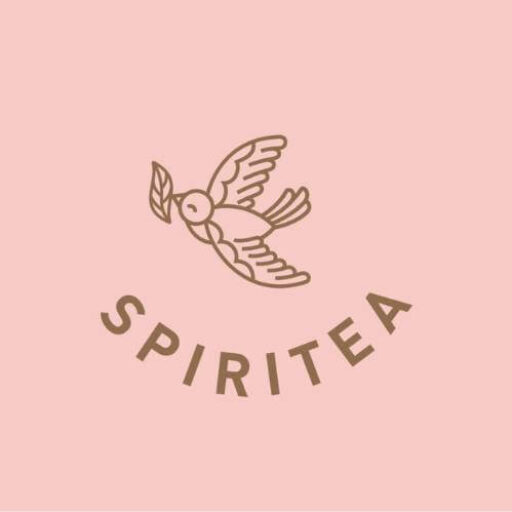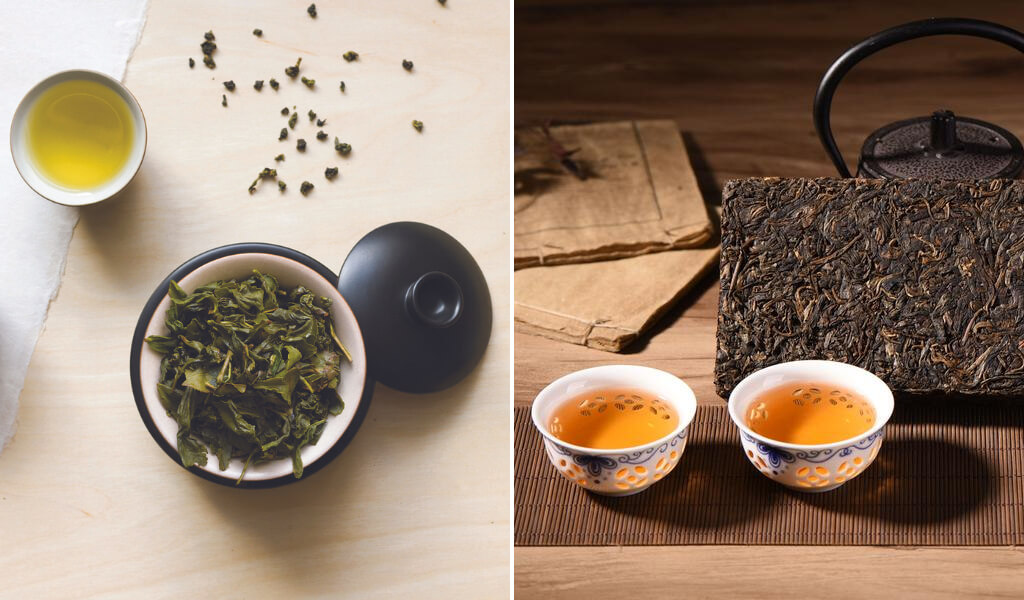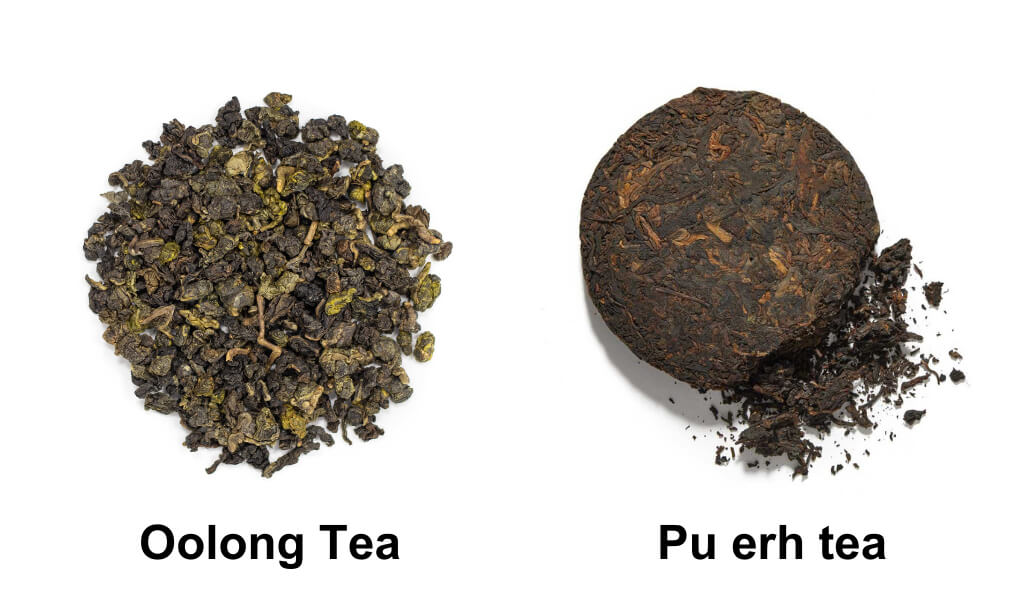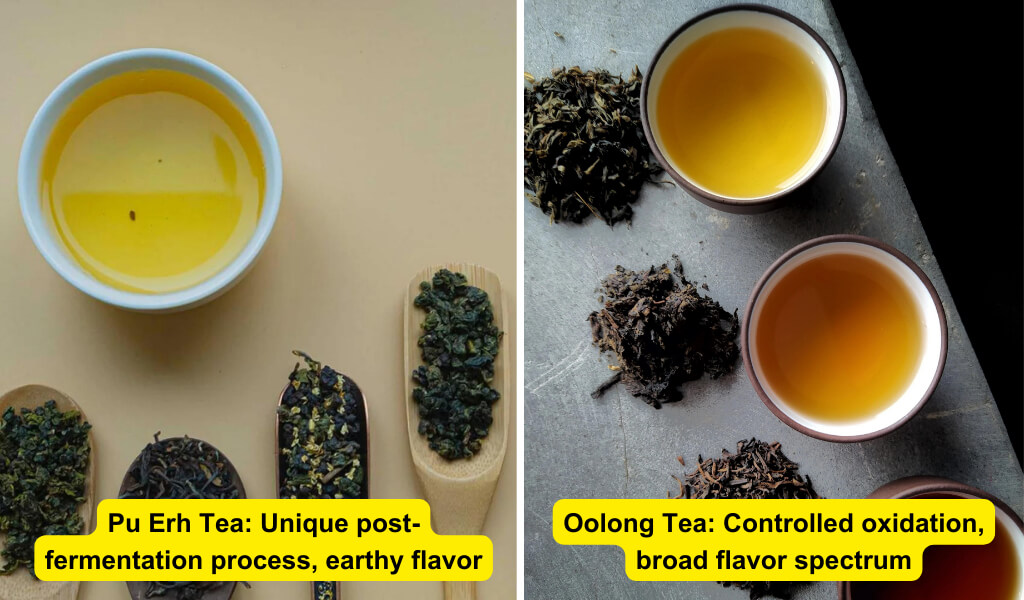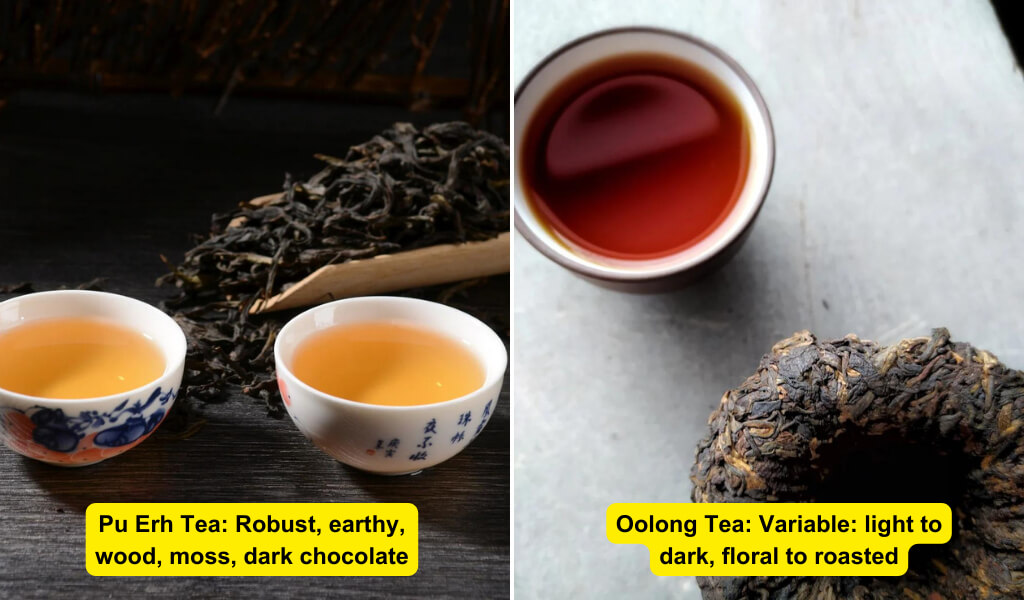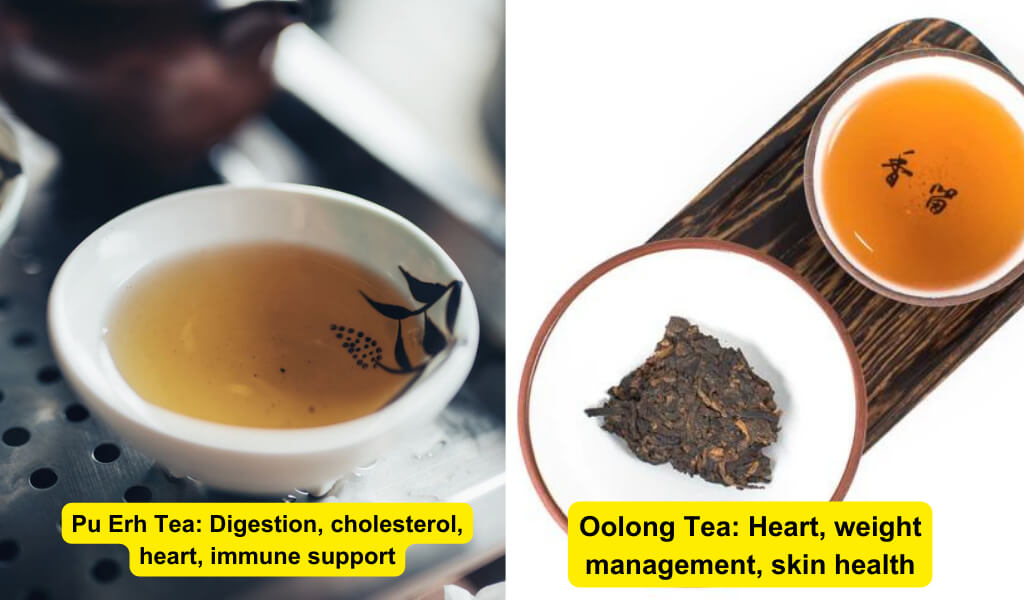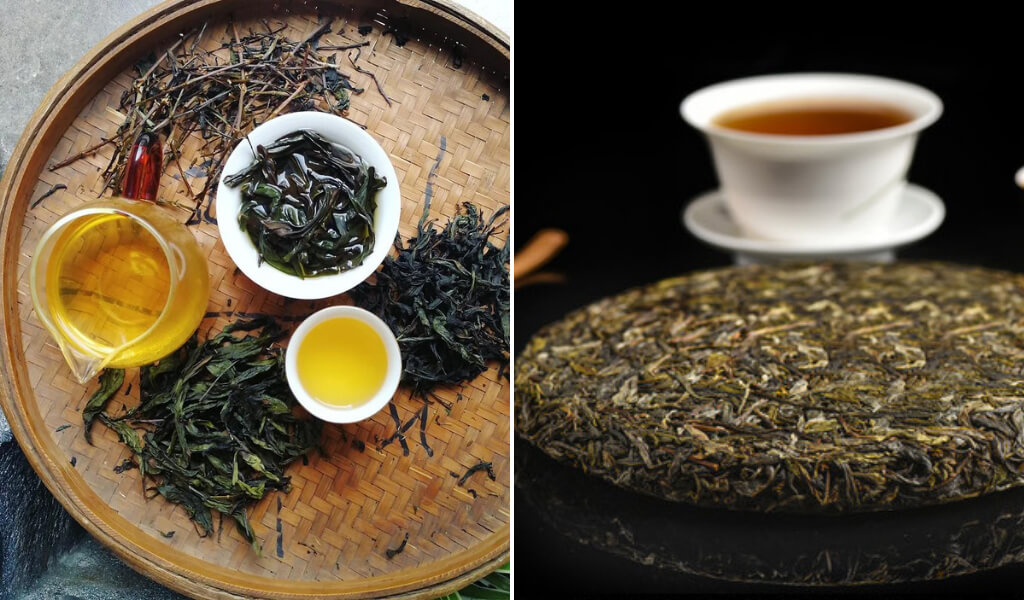Welcome to our deep-dive exploration into the world of “Oolong Tea vs pu erh tea“.
Over the next few sections, I’ll compare these teas regarding taste, nutritional value, health benefits, and more.
Read More:
- Oolong Tea vs White Tea: Comparison on tastes and benefits
- Benefits of Oong Tea vs Green Tea: What are the main difference?
- Oolong vs Black Tea Comparison: Super interesting revelations
Quotes of tea with You
“To tea, without which I would likely be dead.”
– Tara Sim, Timekeeper
Pu Erh vs Oolong Tea: the basics
First, I would like to share my insights on these 2 teas.
What is oolong vs pu erh?
Pu Erh and Oolong are two distinct types of traditional Chinese tea, each with its unique characteristics and allure. Let’s dive a bit deeper.
Pu Erh tea, named after the Pu’er city in Yunnan province, is a fermented tea known for its earthy flavor and profound health benefits. Over the years, it has gained immense popularity among tea enthusiasts for its robust, mature taste and its unique aging process.
Oolong Tea, often considered a semi-fermented tea, falls somewhere between green and black tea in oxidation. It’s cherished for its incredibly diverse flavor profiles, ranging from sweet and floral to creamy and roasted. The multifaceted nature of Oolong tea is a true testament to the artistry involved in its crafting.
Origin and History of pu erh tea vs oolong
Pu Erh tea’s origin traces back to the Han Dynasty (202 BC – 220 AD) when it was used as a form of currency due to its high value. Later, during the Tang Dynasty (618 – 907), it became popular as a tribute tea.
Oolong tea’s history is somewhat more recent, with its development traced back to the Ming Dynasty (1368 – 1644). According to legends, during this era, the tea artisans started experimenting with different fermentation levels, eventually giving birth to Oolong tea.
As I journey through the fascinating pages of “The Book of Tea,” my understanding of these teas deepens.From harvesting to tasting, Pu Erh and Oolong tea intrigue me.
They stand for the unwavering dedication of tea experts who seek excellence in each brew.
We’ll compare and contrast these two beautiful teas as we learn more, giving you a thorough overview that will raise your regard for Pu Erh and Oolong teas.
Difference between Oolong Tea vs pu erh tea
Now, I will go into each criterion to clarify the different points.
| Criteria | Pu Erh Tea | Oolong Tea |
| Making Process | Unique post-fermentation process, earthy flavor | Controlled oxidation, broad flavor spectrum |
| Creation Process | Withering, “kill-green,” oxidation, sun-drying | Withering, oxidation, bruising, shaping |
| Taste | Robust, earthy, wood, moss, dark chocolate | Variable: light to dark, floral to roasted |
| Nutrition | Higher GABA, lovastatin, antioxidants | Antioxidants, theaflavins, catechins |
| Health Benefits | Digestion, cholesterol, heart, immune support | Heart, weight management, skin health |
| Weight Loss Benefits | Fat suppression, metabolism, digestion | Metabolism, fat burning, blood sugar control |
| Caloric Content | Virtually zero calories | Virtually zero calories |
| Brewing Temperature | 70-80°C for robust flavor | Boiling water for full flavors |
| Overnight Brews | Safe to drink overnight | Not advisable due to tannic acid |
The Making Process: Pu Erh Tea vs. Oolong Tea
While both Pu Erh and Oolong teas undergo a process of withering, oxidation, and heat treatment, the difference lies in the details. Pu Erh tea, especially Shou Pu Erh, undergoes a unique post-fermentation process, which gives it its distinct earthy flavor. On the other hand, the oxidation level in Oolong tea is carefully controlled, ranging from 8% to 80%, giving it a broad spectrum of flavor profiles.
Pu Erh tea’s creation is a true artisanal process. The leaves for Pu Erh are picked from the Camellia sinensis var. assamica plant, a variety of tea plant native to Yunnan. Once plucked, the leaves are withered to reduce moisture. They are then pan-fired briefly to halt the enzyme activity, a step known as “kill-green” or “Sha Qing.”
Next, the leaves are rolled to bruise the leaf edges and facilitate oxidation. The semi-fermented leaves are then sun-dried, resulting in raw Pu Erh, also known as ‘Sheng.’ Some Pu Erh undergoes an additional step – a controlled microbial fermentation process known as ‘Wo Dui,’ which ages the tea quickly and imparts a unique earthy flavor, producing ‘Shou’ or ripe Pu Erh.
The production of Oolong tea is an intricate dance of precision and craftsmanship. The tea leaves, usually picked from the Camellia sinensis plant, are withered under the sun to initiate oxidation. This process is closely monitored as the degree of oxidation will significantly impact the flavor profile.
The leaves are then shaken in bamboo trays to bruise the edges, further promoting oxidation. Once the desired oxidation level is reached, the leaves are heat-treated to stop the oxidation process. They are then rolled and shaped before the final roasting, contributing to Oolong’s complex flavor and aroma.
Oolong tea vs pu erh tea taste
Pu Erh and Oolong tea taste is influenced by various factors such as the tea plant varietal, terroir, harvest time, and meticulous processing techniques.
The taste of Pu Erh tea is an exciting journey for your palate. Known for its robust, earthy flavor, Pu Erh tea often carries notes of wood, moss, and sometimes a hint of dark chocolate or ripe fruit. The taste can be intense for first-time drinkers, but this distinctive, complex flavor profile has earned Pu Erh a dedicated following among tea lovers.
With Oolong tea, it’s a delightful surprise with every sip. The flavor profile can greatly vary, depending on the oxidation level and roasting process. It can range from light and floral to dark and roasted, with possible notes of honey, orchids, fresh cream, and toasted nuts. This incredible diversity is one of the reasons why Oolong tea captivates so many tea enthusiasts.
Oolong tea vs pu erh tea nutrition
Due to its fermentation process, Pu Erh tea contains higher levels of GABA and lovastatin. In contrast, Oolong tea, depending on its oxidation level, can have varying antioxidant compositions.
Pu Erh tea is a nutritional powerhouse. It’s rich in antioxidants, especially theaflavins, thearubigins, and catechins, that contribute to overall health. Additionally, it has necessary nutrients, including calcium, potassium, and vitamin C. It’s interesting to note that Pu Erh’s GABA and lovastatin content rises due to the microbial fermentation process, both of which are recognized to have potential health advantages.
Oolong tea, too, is brimming with health-promoting compounds. It is packed with antioxidants like theaflavins and catechins, which support heart health and weight management. Oolong tea also contains essential vitamins and minerals such as vitamin A, B, calcium, and potassium.
Health Benefits: Pu Erh Tea vs. Oolong Tea
Oolong Tea Vs White Tea: Which One Is Healthier? While both teas have some similar health advantages, such supporting heart health and perhaps regulating blood sugar, they each shine in a distinct area. While Oolong tea is frequently commended for its ability to help with weight control and skin health, Pu Erh tea excels in assisting digestion and cholesterol management.
Pu Erh tea is truly a health elixir. Thanks to the natural statins produced during fermentation, it’s renowned for aiding digestion and reducing cholesterol levels. Pu Erh tea can also enhance heart health and boost the immune system. Remarkably, some studies also suggest that regular consumption of Pu Erh tea can help regulate blood sugar levels and support healthy bones.
Oolong tea is a health treasure trove. Its substantial antioxidant content aids in the fight against free radicals, enhancing general heart health. By increasing metabolism and fat burning, oolong tea is also well known for helping with weight management. Additionally, it could support strong bones, good skin, and a healthy brain. Some research even suggests that Oolong tea can help stabilize blood sugar levels.
Oolong Tea vs Pu Erh Tea Weight Loss
Both Pu Erh and Oolong teas have significant weight loss benefits. Some might find the metabolism-boosting properties of Oolong more effective, while others might benefit more from Pu Erh’s fat suppression and digestive aid.
Pu Erh tea can be a great ally in your weight loss journey. It’s known to help suppress fat production and speed up the body’s metabolism. Moreover, Pu Erh tea’s natural compounds help improve digestion, reducing bloating and promoting a healthier body weight.
Oolong tea is celebrated for its weight loss benefits. Its unique combination of catechins and caffeine is known to help increase metabolism and fat burning. Additionally, Oolong tea may help regulate blood sugar levels, thus reducing cravings and supporting weight management.
Caloric Content: Oolong Tea vs. Pu Erh Tea
Considering both Pu Erh and Oolong teas are virtually calorie-free, choosing between the two based on caloric content alone might not be significant.
Pu Erh tea is quite low in calories. A standard cup of Pu Erh tea (without any additives like sugar or milk) contains virtually zero calories, making it a great choice for those on a calorie-restricted diet.
Like Pu Erh, Oolong tea is also virtually calorie-free when brewed without additives. This makes it an excellent choice for those trying to manage their weight or follow a low-calorie diet.
Brewing Temperature
One difference that stands out is the brewing temperature. You’d need to use boiling water to unleash Taiwanese Oolong tea’s delightful flavors fully. The heat allows the complex aromas and flavors to be released effectively.
On the other hand, Pu Erh tea is more of a gentle soul. It requires a lower water temperature, around 70 to 80 degrees Celsius, to reveal its robust, earthy flavors. This difference in brewing temperatures adds another layer of uniqueness to these tea experiences.
Drinking Overnight Brews
Another key distinction lies in the drinkability of overnight brews.
You’ll find this information useful if you need to remember your tea only to remember it the next day (we’ve all been there).
Overnight Oolong tea is not typically advisable to drink. This tea contains tannic acid, which, when left overnight, could potentially irritate the stomach. Therefore, it’s always best to enjoy your Oolong tea fresh.
On the flip side, Pu Erh tea is far more forgiving. Even if left overnight, it poses a different issue. Thanks to its unique fermentation process, Pu Erh tea doesn’t harm your stomach, making it safe to sip even the next day. Knowing you can return to your forgotten cup of Pu Erh tea without worry is comforting.
Defining Pu Erh and Puerh Tea
Firstly, let’s define these two entities. As we’ve been exploring, Pu Erh tea is a fermented tea from Yunnan Province in China. It’s known for its earthy flavor and myriad health benefits.
You might be surprised to learn that ‘Puerh tea’ isn’t a different kind of tea. It refers to the same fermented tea from Yunnan. The difference is solely in the transliteration of the Chinese characters into English.
Conclusion
We’ve journeyed through Oolong Tea vs pu erh tea, exploring their origins, brewing processes, tastes, nutritional benefits, and more. I hope this journey has been as enlightening for you as it has been for me.
Key Takeaways: Let’s quickly revisit what we’ve learned. Pu Erh and Oolong teas are revered for their unique flavors and health benefits. Pu Erh’s earthy flavors, fermentation process, and digestion-supporting properties are as fascinating as nourishing. With its floral notes, variable oxidation levels, and metabolism-boosting benefits, Oolong offers an equally captivating tea experience.
Also, remember that Pu Erh tea and Puerh tea are the same, spelled differently due to translation variations.
Making Your Choice: Which Tea Suits You Best?
Ultimately, the choice between Pu Erh and Oolong boils down to personal preference. Do you gravitate towards the earthy, rich flavor of Pu Erh, or do you prefer the floral, complex notes of Oolong? Are you looking for a tea that supports digestion like Pu Erh, or are you more interested in the metabolism-boosting properties of Oolong?
It’s your taste and body, so the decision is all yours. Regardless of your choice, remember that each cup of tea is an experience, a moment of tranquillity in our bustling lives.
The article is based on the information and experience of the Spiritea drinks team.
FAQs
Are Pu Erh and Oolong tea safe for everyone to drink?
Pu Erh and Oolong teas are generally safe for most people to consume. However, they contain caffeine, which might be problematic for sensitive people. As with any food or drink, it’s always best to consult a healthcare provider if you have any concerns or underlying health conditions.
Can Pu Erh and Oolong teas be consumed during intermittent fasting?
Yes, Pu Erh and Oolong teas can be consumed during intermittent fasting. Oolong tea vs pu erh tea calories are low and do not usually break a fast. However, adding any sweeteners or milk would contribute to your calorie intake.
How often can I drink Pu Erh or Oolong tea?
As these teas contain caffeine, it’s best not to overconsume them. Depending on individual caffeine sensitivity, 3-4 cups daily is usually a safe limit for most people. As always, listen to your body and adjust accordingly.
How should I store Pu Erh and Oolong teas?
Both teas should be stored in a cool, dark place, away from strong odors. While Oolong tea should be consumed relatively quickly, Pu Erh can be aged for many years, which enhances its flavor profile.
I’m Shanna, creator of Spiritea Drinks. I’m all about teaching people to grow their own food, tea, cook what they harvest, and eat with the seasons.
